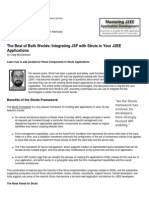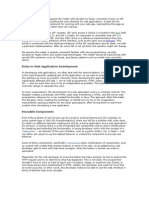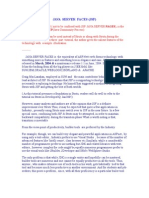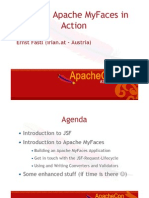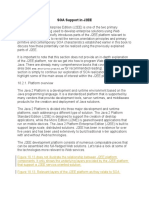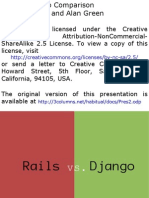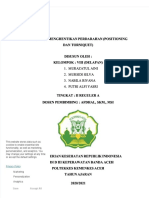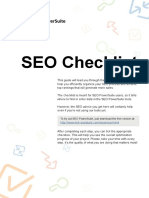JavaServer Faces
JavaServer Faces
Uploaded by
sohelsunCopyright:
Available Formats
JavaServer Faces
JavaServer Faces
Uploaded by
sohelsunCopyright
Available Formats
Share this document
Did you find this document useful?
Is this content inappropriate?
Copyright:
Available Formats
JavaServer Faces
JavaServer Faces
Uploaded by
sohelsunCopyright:
Available Formats
Stable release 2.2.
7 (Mojarra Reference
Implementation) / June 10, 2014
Written in Java
Type Web application framework
Website javaserverfaces.java.net
(http://javaserverfaces.java.net/)
JavaServer Faces
JavaServer Faces
From Wikipedia, the free encyclopedia
JavaServer Faces (JSF) is a Java specification for
building component-based user interfaces for web
applications.
[1]
It was formalized as a standard
through the Java Community Process and is part of
the Java Platform, Enterprise Edition.
JSF 2 uses Facelets as its default templating system.
Other view technologies such as XUL can also be
employed. In contrast, JSF 1.x uses JavaServer Pages
(JSP) as its default templating system.
Contents
1 JSF versions
2 How it works
3 JSF and Ajax
4 Ajax-enabled components and frameworks
5 Latest developments
6 Criticism
7 References
7.1 Notes
8 External links
JSF versions
JSF 2.2 (2013-05-21) Introduced new concepts like stateless views, page flow and the ability to
create portable resource contracts.
[2]
JSF 2.1 (2010-11-22) Maintenance release 2 of JSF 2.0. Only very minor amount of spec changes.
[3][4]
JSF 2.0 (2009-07-01) Major release for ease of use, enhanced functionality, and performance.
Coincides with Java EE 6.
JSF 1.2 (2006-05-11) Many improvements to core systems and APIs. Coincides with Java EE 5.
Initial adoption into Java EE.
JSF 1.1 (2004-05-27) Bug fix release. No specification changes.
JSF 1.0 (2004-03-11) Initial specification released.
How it works
Based on a component-driven UI design-model, JavaServer Faces uses XML files called view templates or
JavaServer Faces - Wikipedia, the free encyclopedia http://en.wikipedia.org/wiki/JavaServer_Faces
1 sur 4 15/07/2014 14:01
Facelets views. The FacesServlet processes requests, loads the appropriate view template, builds a
component tree, processes events, and renders the response (typically in the HTML language) to the client.
The state of UI components and other objects of scope interest is saved at the end of each request in a
process called stateSaving (note: transient true), and restored upon next creation of that view. Either the
client or the server side can save objects and states.
JSF and Ajax
JSF is often used together with Ajax, a Rich Internet application technology. Ajax is a combination of
technologies that make it possible to create rich user interfaces. The user interface components in Mojarra
(the JSF reference implementation
[5]
) and Apache MyFaces were originally developed for HTML only, and
Ajax had to be added via JavaScript. This has changed, however:
Because JSF supports multiple output formats, Ajax-enabled components can easily be added to enrich
JSF-based user interfaces. The JSF 2.0 specification provides built in support for Ajax by standardizing the
Ajax request lifecycle, and providing simple development interfaces to Ajax events, allowing any event
triggered by the client to go through proper validation, conversion, and finally method invocation, before
returning the result to the browser via an XML DOM update.
JSF 2 includes support for graceful degradation when JavaScript is disabled in the browser.
Ajax-enabled components and frameworks
The following companies and projects offer Ajax-based JSF frameworks or component libraries:
PrimeFaces Ajax framework with JSF components
JBoss RichFaces (derived from and replaces Ajax4jsf), Ajax-enabled JSF components for layout, file
upload, forms, inputs and many other features.
Oracle ADF Faces Rich Client, Oracle Application Development Framework
Backbase Enterprise Ajax JSF Edition, Ajax framework
IBM Notes - XPages
Apache MyFaces, The Apache Foundation JSF implementation with Ajax components
Sun Java BluePrints AJAX Components
ZK Ajax framework with JSF components
ICEfaces, open-source, Java JSF extension framework and rich components, Ajax without JavaScript
Latest developments
Facelets (which was designed specifically for JavaServer Faces) was adopted as the official view technology
for JSF 2.0. This eliminates the life-cycle conflicts that existed with JSP, forcing workarounds by Java
developers.
[6]
Facelets allows easy component/tag creation using XML markup instead of Java code, the
chief complaint against JSF 1.x.
The new JSF developments also provide wide accessibility to Java 5 annotations such as @ManagedBean,
@ManagedProperty and @FacesComponent which removes the need for faces-config.xml in all cases
except framework extension. Navigation has been simplified, removing the need for faces-config.xml
navigation cases. Page transitions can be invoked simply by passing the name of the desired View/Facelet.
JavaServer Faces - Wikipedia, the free encyclopedia http://en.wikipedia.org/wiki/JavaServer_Faces
2 sur 4 15/07/2014 14:01
Addition of Partial State Saving and DOM updates are part of the built in standardized Ajax support.
The latest JSF release has built-in support for handling resources like images, CSS and Javascript, allowing
artifacts to be included with component libraries, separated into JAR files, or simply co-located into a
consistent place within the web-application. Includes logical naming and versioning of resources.
JSF 2.0 also includes a number of other changes like adding support for events, separate development,
staging, and production modes, similar to RAILS_ENV in Ruby on Rails, and significantly expanding the
standard set of components.
Criticism
In their January 2014 "Technology Radar" publication, ThoughtWorks wrote:
[7]
We continue to see teams run into trouble using JSF -- JavaServer Faces -- and are
recommending you avoid this technology. Teams seem to choose JSF because it is a J2EE (sic)
standard without really evaluating whether the programming model suits them. We think JSF is
flawed because it tries to abstract away HTML, CSS and HTTP, exactly the reverse of what
modern web frameworks do. JSF, like ASP.NET webforms, attempts to create statefulness on
top of the stateless protocol HTTP and ends up causing a whole host of problems involving
shared server-side state. We are aware of the improvements in JSF 2.0, but think the model is
fundamentally broken. We recommend teams use simple frameworks and embrace and
understand web technologies including HTTP, HTML and CSS.
References
Oracle JavaServer Faces Technology (http://www.oracle.com/technetwork/java/javaee
/javaserverfaces-139869.html)
JSF specification (https://javaserverfaces.java.net/)
JSR 344 (http://www.jcp.org/en/jsr/detail?id=344) (JSF 2.2)
JSR 314 (http://www.jcp.org/en/jsr/detail?id=314) (JSF 2.0 and JSF 2.1)
JSR 252 (http://www.jcp.org/en/jsr/detail?id=252) (JSF 1.2)
JSR 127 (http://www.jcp.org/en/jsr/detail?id=127) (JSF 1.0 and 1.1)
JSR 316 (http://jcp.org/en/jsr/detail?id=316) (Changes to JSF 2.0 in Java EE 6)
Notes
^ JavaServer Faces Technology (http://www.oracle.com/technetwork/java/javaee/javaserverfaces-139869.html) 1.
^ JSF 2.2 (JSR-344) is final | techscouting through the java news (http://blog.oio.de/2013/04/16/jsf-2-2-jsr-
344-is-final/). Blog.oio.de. Retrieved on 2013-07-29.
2.
^ JSR 314 JavaServer Faces 2.1 JSF 2.1 | techscouting through the java news (http://blog.oio.de/2010/11/24/jsr-
000314-javaservertm-faces-2-1/). Blog.oio.de. Retrieved on 2013-07-29.
3.
^ Bosch, Andy (2010-11-29). "Was ist neu in JSF 2.1" (http://it-republik.de/jaxenter/news/Was-ist-neu-in-JSF-
2.1-057653.html) (in German). it-republik.de. Retrieved 2013-02-19.
4.
^ Ryan Lubke (5 December 2007). "Project Mojarra - the JSF RI gets a code name" (https://blogs.oracle.com
/rlubke/entry/project_mojarra_the_jsf_ri).
5.
^ Bergsten, Hans. "Improving JSF by dumping JSP" (http://onjava.com/pub/a/onjava/2004/06/09/jsf.html). 6.
JavaServer Faces - Wikipedia, the free encyclopedia http://en.wikipedia.org/wiki/JavaServer_Faces
3 sur 4 15/07/2014 14:01
O'Reilly. Retrieved 18 August 2011.
^ "Technology Radar" (http://thoughtworks.fileburst.com/assets/technology-radar-jan-2014-en.pdf).
ThoughtWorks. January 2014. p. 12.
7.
External links
Official website (http://javaserverfaces.java.net) The project page for JSF at java.net
Core Servlets JSF Tutorials (http://www.coreservlets.com/JSF-Tutorial/) Tutorials with Source Code
ICEfaces (http://www.icesoft.org) Official site of the ICEfaces Open Source Project
JSR 276 (http://www.jcp.org/en/jsr/detail?id=276) Design-Time Metadata for JavaServer Faces
Components
James Holmes' JSF Resources (http://www.jamesholmes.com/JavaServerFaces/) Extensive listing of
JSF articles, blog entries, tutorials, and more
JSF Central (http://www.jsfcentral.com/) JavaServer Faces Community
Java EE 4 Tutorial (http://java.sun.com/j2ee/1.4/docs/tutorial/doc) Chapter 17: JavaServer Faces
Technology (http://java.sun.com/j2ee/1.4/docs/tutorial/doc/JSFIntro.html)
Java EE 5 Tutorial (http://java.sun.com/javaee/5/docs/tutorial/doc/) Chapter 10: JavaServer Faces
Technology (http://download.oracle.com/javaee/5/tutorial/doc/bnaph.html)
Java EE 6 Tutorial (http://java.sun.com/javaee/6/docs/tutorial/doc/) Chapter 4: JavaServer Faces
Technology (http://download.oracle.com/javaee/6/tutorial/doc/bnaph.html)
Java EE 7 Tutorial (http://docs.oracle.com/javaee/7/tutorial/doc/home.htm) Chapter 7: JavaServer
Faces Technology (http://docs.oracle.com/javaee/7/tutorial/doc/jsf-intro.htm)
JSF Tutorials, Examples and Articles catalog (http://www.jsftutorials.net)
JSF Matrix (http://www.jsfmatrix.net/) listing various JSF implementations and their features
Brief review (http://www.theserverside.com/tt/articles/article.tss?l=JavaEE6Overview) on the latest
changes to JSF 2.0 to be reflected in Java EE 6
PrimeFaces (http://www.primefaces.org) Official site PrimeFaces
JSF Tutorial Sitenol (http://www.sitenol.com/java-server-faces-jsf-tutorial-with-examples) JSF
tutorials, examples and good email support for coding problems
Retrieved from "http://en.wikipedia.org/w/index.php?title=JavaServer_Faces&oldid=615189777"
Categories: JavaServer Faces Java enterprise platform Java specification requests
Web application frameworks 2004 introductions
This page was last modified on 1 July 2014 at 18:43.
Text is available under the Creative Commons Attribution-ShareAlike License; additional terms may
apply. By using this site, you agree to the Terms of Use and Privacy Policy. Wikipedia is a registered
trademark of the Wikimedia Foundation, Inc., a non-profit organization.
JavaServer Faces - Wikipedia, the free encyclopedia http://en.wikipedia.org/wiki/JavaServer_Faces
4 sur 4 15/07/2014 14:01
You might also like
- నక్షత్ర చింతామణి-NakshatraChintaamaniDocument178 pagesనక్షత్ర చింతామణి-NakshatraChintaamaniPantula Venkata Radhakrishna81% (94)
- Spring Notes PDFDocument55 pagesSpring Notes PDFVenkat Gowda100% (1)
- SEO Seminar ReportDocument15 pagesSEO Seminar Reporthc100% (1)
- Ibm JSFDocument42 pagesIbm JSFksknrindianNo ratings yet
- JSFDocument10 pagesJSFsaumitra2No ratings yet
- Developing Rich Web Applications With Prime Faces in Java EE7Document14 pagesDeveloping Rich Web Applications With Prime Faces in Java EE7tdc981No ratings yet
- Java Server Faces: St. Louis Javasig June 8, 2006 Jay Meyer, Harpoon TechnologiesDocument24 pagesJava Server Faces: St. Louis Javasig June 8, 2006 Jay Meyer, Harpoon TechnologiesAshish GuptaNo ratings yet
- JSF @RoseIndiaDocument251 pagesJSF @RoseIndiamalli.gontla3724No ratings yet
- The Best of Both Worlds: Integrating JSF With Struts in Your J2EE ApplicationsDocument9 pagesThe Best of Both Worlds: Integrating JSF With Struts in Your J2EE ApplicationsLuis Roger Martinez ZaldivarNo ratings yet
- JSFDocument258 pagesJSFunnikrishnan.a.sNo ratings yet
- Java Server Faces: St. Louis Javasig June 8, 2006 Jay Meyer, Harpoon TechnologiesDocument24 pagesJava Server Faces: St. Louis Javasig June 8, 2006 Jay Meyer, Harpoon TechnologiesShailaja KaringulaNo ratings yet
- Java Server FacesDocument24 pagesJava Server FacesPonezhil RamuNo ratings yet
- JSF - Java Server Faces Tutorials Complete Java Server Faces (JSF) Tutorial - JSF TutorialsDocument66 pagesJSF - Java Server Faces Tutorials Complete Java Server Faces (JSF) Tutorial - JSF TutorialsAravind RadhakrishnanNo ratings yet
- Java ChearDocument2 pagesJava Chearsuraj nathNo ratings yet
- Real-Time Auction Service Application Based On Frameworks Available For J2EE PlatformDocument5 pagesReal-Time Auction Service Application Based On Frameworks Available For J2EE Platformskumar51907740No ratings yet
- JSF Interview Questions and AnswersDocument13 pagesJSF Interview Questions and AnswersDeepak BhagatNo ratings yet
- Java Server FacesDocument20 pagesJava Server Facesakbala08No ratings yet
- Js F Overview 80Document16 pagesJs F Overview 80Gil DemetrioNo ratings yet
- JavaServer Faces TechnologyDocument1 pageJavaServer Faces TechnologyreyhdezmNo ratings yet
- JSF Interview Questions: Tutorial CategoriesDocument7 pagesJSF Interview Questions: Tutorial CategoriesRatnesh KumarNo ratings yet
- J Richfaces PDFDocument22 pagesJ Richfaces PDFPrabhath Kausthubha N KNo ratings yet
- SCEA Chapter 3 DraftDocument10 pagesSCEA Chapter 3 DraftjiturbideNo ratings yet
- Web Application Architecture (Based J2EE 1.4 Tutorial)Document48 pagesWeb Application Architecture (Based J2EE 1.4 Tutorial)Smita R. S.No ratings yet
- Introduction To JavaServer Faces 2Document24 pagesIntroduction To JavaServer Faces 2phibao37No ratings yet
- Java DeveloperDocument3 pagesJava DeveloperRaj SamunuriNo ratings yet
- Getting Started With Javaserver Faces 1.2, Part 1:: Building Basic ApplicationsDocument49 pagesGetting Started With Javaserver Faces 1.2, Part 1:: Building Basic ApplicationsdipenyadavNo ratings yet
- Roles in Web-Application DevelopmentDocument7 pagesRoles in Web-Application DevelopmentsatyanarayanaNo ratings yet
- Javascript NotesDocument20 pagesJavascript Notesbawol18353No ratings yet
- Java Server Faces JSF PresentationDocument47 pagesJava Server Faces JSF PresentationMajid KhanNo ratings yet
- Java Server Faces (JSF) : JAVA SERVER FACES (Not To Be Confused With JSP..JAVA SERVER PAGES), Is TheDocument30 pagesJava Server Faces (JSF) : JAVA SERVER FACES (Not To Be Confused With JSP..JAVA SERVER PAGES), Is ThesatyanarayanaNo ratings yet
- JSF 1Document3 pagesJSF 1haiyaramalaNo ratings yet
- Java Server Faces Interview Questions and Answers 1072Document7 pagesJava Server Faces Interview Questions and Answers 1072sreenathms488No ratings yet
- 4.introduction To JavaServer Faces 2Document31 pages4.introduction To JavaServer Faces 2saraNo ratings yet
- JSF Portlet IntroductionDocument9 pagesJSF Portlet IntroductionUday KiranNo ratings yet
- Java Server Faces (JSF) Online TrainingDocument4 pagesJava Server Faces (JSF) Online TrainingGloryittechnologiesNo ratings yet
- Ajax FrameworksDocument45 pagesAjax FrameworksRicky HoyaNo ratings yet
- Ravi Java ResumeDocument8 pagesRavi Java Resumert231No ratings yet
- JavaServer Faces For 353Document15 pagesJavaServer Faces For 353Angshusmita Baruah SegraNo ratings yet
- MyFaces TutorialDocument192 pagesMyFaces Tutorialmadan100% (7)
- Struts OverviewDocument2 pagesStruts OverviewariesanacondaNo ratings yet
- WT - Module - V JSFDocument21 pagesWT - Module - V JSFmreccsaNo ratings yet
- SRS Format by TGMCDocument9 pagesSRS Format by TGMCashokcsNo ratings yet
- Java Server Faces Web Applications: Unit-V Internet ProgrammingDocument24 pagesJava Server Faces Web Applications: Unit-V Internet Programmingrichamehra2003No ratings yet
- SOA Support in JavaDocument21 pagesSOA Support in JavaBala SubramanianNo ratings yet
- Introduction To Javaserver Faces V2.0Document34 pagesIntroduction To Javaserver Faces V2.0rama0206No ratings yet
- My Study NotesDocument5 pagesMy Study Notescgyang777No ratings yet
- Framework OverviewDocument3 pagesFramework OverviewAjoy MahaNo ratings yet
- Srs FormatDocument25 pagesSrs FormatVikash Kumar GiriNo ratings yet
- Javafx: by Chandani ThackerDocument20 pagesJavafx: by Chandani ThackerAnnas BlackHatNo ratings yet
- Spring IntroDocument10 pagesSpring Introaccelia.sNo ratings yet
- Max Katz Senior Systems Engineer ExadelDocument52 pagesMax Katz Senior Systems Engineer ExadelRogie RogelioNo ratings yet
- 1.1.1 JavaDocument19 pages1.1.1 JavaMAHALINGASWAMY M BNo ratings yet
- Search: - Simplify Your Steps To Success With Wipro's Unified Communication SolutionsDocument3 pagesSearch: - Simplify Your Steps To Success With Wipro's Unified Communication Solutionsmsc_santuNo ratings yet
- Unit-5 JAVA FX ProgrammingDocument104 pagesUnit-5 JAVA FX Programmingdharunm635No ratings yet
- AnushaK JavaDocument6 pagesAnushaK JavaSantosh Reddy ChennuruNo ratings yet
- Anusha SR Java J2EE DeveloperDocument5 pagesAnusha SR Java J2EE DeveloperAnusha RNo ratings yet
- SRS FormatDocument9 pagesSRS Formataparna517No ratings yet
- Digital Java EE 7 Web Application DevelopmentFrom EverandDigital Java EE 7 Web Application DevelopmentRating: 4 out of 5 stars4/5 (1)
- The Complete Developer: Master the Full Stack with TypeScript, React, Next.js, MongoDB, and DockerFrom EverandThe Complete Developer: Master the Full Stack with TypeScript, React, Next.js, MongoDB, and DockerNo ratings yet
- Payara ServerDocument3 pagesPayara ServersohelsunNo ratings yet
- Java Authentication and Authorization ServiceDocument4 pagesJava Authentication and Authorization ServicesohelsunNo ratings yet
- Java Platform, Enterprise EditionDocument12 pagesJava Platform, Enterprise EditionsohelsunNo ratings yet
- Amazon Elastic Compute CloudDocument8 pagesAmazon Elastic Compute CloudsohelsunNo ratings yet
- LibreOffice - Calc GuideDocument446 pagesLibreOffice - Calc Guidencezar2000No ratings yet
- Workbench User GuideDocument389 pagesWorkbench User GuidesohelsunNo ratings yet
- Tuning DerbyDocument72 pagesTuning DerbysohelsunNo ratings yet
- LIbreOffice - Math GuideDocument63 pagesLIbreOffice - Math Guidencezar2000No ratings yet
- LibreOffice MathGuideDocument56 pagesLibreOffice MathGuideEster BeltramiNo ratings yet
- 3 "Getting Started" ManualDocument442 pages3 "Getting Started" ManualONETRUEGEMLLCNo ratings yet
- Joomla 1.7 Beginners Guide PDFDocument256 pagesJoomla 1.7 Beginners Guide PDFYatiri KallawayaNo ratings yet
- Learn Handlebars in 10 Minutes or LessDocument3 pagesLearn Handlebars in 10 Minutes or Lesserpiyushkumar1No ratings yet
- Answer:: If None of These Files Are Found, Server Renders 404 ErrorDocument3 pagesAnswer:: If None of These Files Are Found, Server Renders 404 Erroreppili santoshkumarNo ratings yet
- Front-End Web Dev Roadmap 2 PDFDocument1 pageFront-End Web Dev Roadmap 2 PDFasad arNo ratings yet
- Seo CourseDocument427 pagesSeo CourseMarina ShilovaNo ratings yet
- 1) Fangofood Homepage: (Only For Home Page) : How We Conducted Keyword ResearchDocument5 pages1) Fangofood Homepage: (Only For Home Page) : How We Conducted Keyword ResearchRitik BhardwajNo ratings yet
- WebometricsDocument22 pagesWebometricsWEBOMETRICSNo ratings yet
- Theory Assignement - UNIT - I & IIDocument1 pageTheory Assignement - UNIT - I & IIGopal. Gehlot.No ratings yet
- Invision Power Board - Vulnerability Report: Project Insecurity - Insecurity - SHDocument13 pagesInvision Power Board - Vulnerability Report: Project Insecurity - Insecurity - SHInsecurity TubeNo ratings yet
- Vehicle Booking SystemDocument2 pagesVehicle Booking SystemMd Kamruzzaman KhanNo ratings yet
- Fortigate Https Webfiltering Without SSL Deep Scan 50 PDFDocument3 pagesFortigate Https Webfiltering Without SSL Deep Scan 50 PDFhudsonsaNo ratings yet
- Rails/Django ComparisonDocument100 pagesRails/Django ComparisonPascal Van Hecke100% (17)
- What Is Technical SEODocument5 pagesWhat Is Technical SEOMohammed Sayeeduddin100% (1)
- Digital Marketing Course Ghaziabad PDFDocument7 pagesDigital Marketing Course Ghaziabad PDFChirag seoexpertNo ratings yet
- PDF Makalah Tindakan Menghentikan Perdarahan Positioning Dan Tourniquet DLDocument22 pagesPDF Makalah Tindakan Menghentikan Perdarahan Positioning Dan Tourniquet DLnang wanNo ratings yet
- Strategy & Proposal For: Platform WordpressDocument32 pagesStrategy & Proposal For: Platform WordpressvivaacpseoNo ratings yet
- A New Approach To Web Applications : © Wipro Technologies - Wipro Confidential - Not For DistributionDocument23 pagesA New Approach To Web Applications : © Wipro Technologies - Wipro Confidential - Not For DistributionsalempradeepNo ratings yet
- Seo Checklist: To Try Out Seo Powersuite, Just Download The Free Version atDocument24 pagesSeo Checklist: To Try Out Seo Powersuite, Just Download The Free Version atShayan KhanNo ratings yet
- LogDocument22 pagesLoghumaNo ratings yet
- Wordstream Seo PDFDocument12 pagesWordstream Seo PDFElias AvilaNo ratings yet
- Getting Single Page Application Security RightDocument170 pagesGetting Single Page Application Security RightvenkateshsjNo ratings yet
- GeDocument2 pagesGeKatsi TovlisNo ratings yet
- Link Building 101Document7 pagesLink Building 101egayamNo ratings yet
- PDF Gravedad en Cochabamba DLDocument5 pagesPDF Gravedad en Cochabamba DLMaison Jhon Quispe TerrazasNo ratings yet
- Document Compatibility InternetExplorer8Document3 pagesDocument Compatibility InternetExplorer8Rodrigo CoimbraNo ratings yet
- Module 1 Keyword ResearchDocument29 pagesModule 1 Keyword Researchalfian gunadiNo ratings yet
- Tic Tac Toe Coding SampleDocument8 pagesTic Tac Toe Coding SampleNiharika JainNo ratings yet
- ExchangeDocument4 pagesExchangeMarcos SachiNo ratings yet
- Backlink SeomucoiDocument34 pagesBacklink SeomucoiNguyen Duc ThinhNo ratings yet








